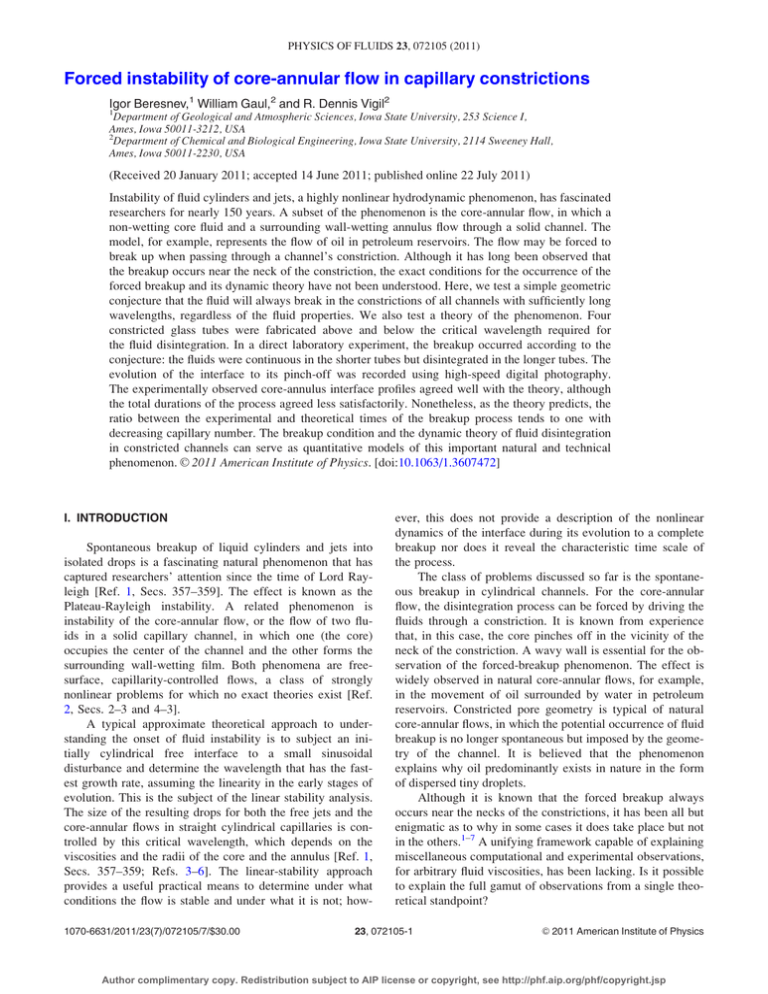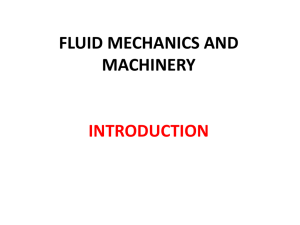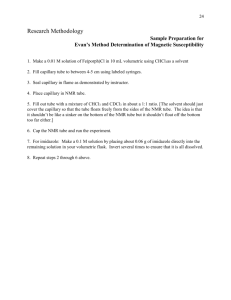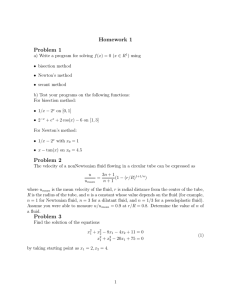Forced instability of core-annular flow in capillary constrictions Igor Beresnev, William Gaul,
advertisement

PHYSICS OF FLUIDS 23, 072105 (2011) Forced instability of core-annular flow in capillary constrictions Igor Beresnev,1 William Gaul,2 and R. Dennis Vigil2 1 Department of Geological and Atmospheric Sciences, Iowa State University, 253 Science I, Ames, Iowa 50011-3212, USA 2 Department of Chemical and Biological Engineering, Iowa State University, 2114 Sweeney Hall, Ames, Iowa 50011-2230, USA (Received 20 January 2011; accepted 14 June 2011; published online 22 July 2011) Instability of fluid cylinders and jets, a highly nonlinear hydrodynamic phenomenon, has fascinated researchers for nearly 150 years. A subset of the phenomenon is the core-annular flow, in which a non-wetting core fluid and a surrounding wall-wetting annulus flow through a solid channel. The model, for example, represents the flow of oil in petroleum reservoirs. The flow may be forced to break up when passing through a channel’s constriction. Although it has long been observed that the breakup occurs near the neck of the constriction, the exact conditions for the occurrence of the forced breakup and its dynamic theory have not been understood. Here, we test a simple geometric conjecture that the fluid will always break in the constrictions of all channels with sufficiently long wavelengths, regardless of the fluid properties. We also test a theory of the phenomenon. Four constricted glass tubes were fabricated above and below the critical wavelength required for the fluid disintegration. In a direct laboratory experiment, the breakup occurred according to the conjecture: the fluids were continuous in the shorter tubes but disintegrated in the longer tubes. The evolution of the interface to its pinch-off was recorded using high-speed digital photography. The experimentally observed core-annulus interface profiles agreed well with the theory, although the total durations of the process agreed less satisfactorily. Nonetheless, as the theory predicts, the ratio between the experimental and theoretical times of the breakup process tends to one with decreasing capillary number. The breakup condition and the dynamic theory of fluid disintegration in constricted channels can serve as quantitative models of this important natural and technical C 2011 American Institute of Physics. [doi:10.1063/1.3607472] phenomenon. V I. INTRODUCTION Spontaneous breakup of liquid cylinders and jets into isolated drops is a fascinating natural phenomenon that has captured researchers’ attention since the time of Lord Rayleigh [Ref. 1, Secs. 357–359]. The effect is known as the Plateau-Rayleigh instability. A related phenomenon is instability of the core-annular flow, or the flow of two fluids in a solid capillary channel, in which one (the core) occupies the center of the channel and the other forms the surrounding wall-wetting film. Both phenomena are freesurface, capillarity-controlled flows, a class of strongly nonlinear problems for which no exact theories exist [Ref. 2, Secs. 2–3 and 4–3]. A typical approximate theoretical approach to understanding the onset of fluid instability is to subject an initially cylindrical free interface to a small sinusoidal disturbance and determine the wavelength that has the fastest growth rate, assuming the linearity in the early stages of evolution. This is the subject of the linear stability analysis. The size of the resulting drops for both the free jets and the core-annular flows in straight cylindrical capillaries is controlled by this critical wavelength, which depends on the viscosities and the radii of the core and the annulus [Ref. 1, Secs. 357–359; Refs. 3–6]. The linear-stability approach provides a useful practical means to determine under what conditions the flow is stable and under what it is not; how1070-6631/2011/23(7)/072105/7/$30.00 ever, this does not provide a description of the nonlinear dynamics of the interface during its evolution to a complete breakup nor does it reveal the characteristic time scale of the process. The class of problems discussed so far is the spontaneous breakup in cylindrical channels. For the core-annular flow, the disintegration process can be forced by driving the fluids through a constriction. It is known from experience that, in this case, the core pinches off in the vicinity of the neck of the constriction. A wavy wall is essential for the observation of the forced-breakup phenomenon. The effect is widely observed in natural core-annular flows, for example, in the movement of oil surrounded by water in petroleum reservoirs. Constricted pore geometry is typical of natural core-annular flows, in which the potential occurrence of fluid breakup is no longer spontaneous but imposed by the geometry of the channel. It is believed that the phenomenon explains why oil predominantly exists in nature in the form of dispersed tiny droplets. Although it is known that the forced breakup always occurs near the necks of the constrictions, it has been all but enigmatic as to why in some cases it does take place but not in the others.1–7 A unifying framework capable of explaining miscellaneous computational and experimental observations, for arbitrary fluid viscosities, has been lacking. Is it possible to explain the full gamut of observations from a single theoretical standpoint? 23, 072105-1 C 2011 American Institute of Physics V Author complimentary copy. Redistribution subject to AIP license or copyright, see http://phf.aip.org/phf/copyright.jsp 072105-2 Beresnev, Gaul, and Vigil Phys. Fluids 23, 072105 (2011) We addressed this question theoretically and computationally in two recent studies. First, starting from an earlier suggestion that the channel geometry plays an important role in the occurrence of fluid breakup,13 we derived an approximate pressure distribution in the core phase based on Laplace’s law of capillary pressure.14 The criterion for the development of instability in a wavy channel can then be formulated as the exceedance in the pressure in the neck of the profile relative to the pressure in the “crest,” causing the core fluid to leave the neck. In geometric terms, for a sinusoidal channel, this leads to an inequality pffiffiffiffiffiffiffiffiffiffiffiffiffiffiffiffi L > 2p rmin rmax ; (1) where L is the wavelength of the channel and rmin and rmax are the minimum and maximum radii of the core phase. It turned out that all published experimental and computational studies of the breakup in flows dominated by capillary forces (that is, having relatively small capillary numbers Ca) in sinusoidal channels, as reviewed by Beresnev et al.,14 complied with this criterion. It is noteworthy that the criterion (1) is derived from a simple pressure argument, although it appears to be universally valid. It should, therefore, be more appropriately called a breakup conjecture. It declares that, regardless of the viscosities of the fluids, geometry is the only factor controlling whether the fluid disintegrates or not. The first goal of the present publication is to subject this conjecture to a direct experimental test. Second, the geometric condition (1) provides a “yes”/“no” answer but does not establish a dynamic model of the phenomenon. We consequently developed a hydrodynamic theory of the forced instability, which, unlike the previous theoretical studies, is able to follow the interface evolution to a complete disintegration for arbitrary viscosities lc and lf of the core and film fluids, respectively (Ref. 15; this publication also summarizes the earlier theoretical studies of the phenomenon). An analytical treatment of this complex hydrodynamic problem is only possible if one assumes smallness of the slope of the interface. For example, suppose the non-dimensional shape of the sinusoidal channel in cylindrical coordinates is kðxÞ ¼ 1 að1 þ cos paxÞ; (2) where kðxÞ is the radial position of the channel’s wall, x is the axial coordinate, a is the geometric parameter quantifying the minimum radius of the pore, and a is the slope constant defining the tube’s wavelength L, a ¼ 2=L (here all quantities having the dimension of distance have been normalized by the maximum radius of the sinusoidal tube Rt). The smallness of the slope is then equivalent to the condition a 1. The small-slope assumption, also supposing the smallness of capillary and Reynolds numbers, allows the use of expressions for Poiseuillean flow for the annulus and the core. The smaller a, the better the approximation. The analysis then leads to a fourth-order nonlinear partial-derivative equation for the temporal evolution of the non-dimensional interface profile jðx; sÞ:15 2 3 2lc k2 1þ 1 7 @j 1 lf Q @ 6 lf j2 6 7 ¼ 6 7 5 @s 2p lc j @x 4 k4 lf þ 1 4 j lc 1 @ @j @3j j2 þ j2 3 þ 4j @x @x @x 99 8 2 > > > k lc 1 k2 3 lc > > > >> > þ < j2 1 lc k== lf 4 j2 4 lf ; ln > > lf j> k4 lf > > > > > > þ 1 ;; : j4 lc (3) where Q is the total volume flux of both fluids through the channel, s is the non-dimensional time (the time normalized by the characteristic time scale lc Rt =r), and r is the corefilm interfacial tension. The equation reflects the complexity of the underlying nonlinear physics but allows inexpensive numerical analysis. An experimental test of the predicted evolution of the interface to its snap-off, governed by Eq. (3), is the second goal of the present study. We are therefore set to perform two tests of the current theoretical understanding of the forced instability in constricted channels. We test the validity of the geometric conjecture (1) for the occurrence of core-fluid disintegration. We also validate the correctness of the dynamic theory expressed by differential Eq. (3). We next describe the laboratory experiments and their results. II. EXPERIMENT Four axisymmetric constricted tubes were manufactured from commercially available straight glass tubing by a glassblower. They will be referred to as the “Short1,” “Short2,” “Medium,” and “Long” models. The geometry was prescribed in such a way that the wavelengths of the Short1 and Short2 tubes did not satisfy the condition (1); the core fluid, therefore, was not expected to snap off. These were the shortest that the glassblower could produce. On the other hand, the wavelengths of the Medium and Long tubes satisfied the condition. These tubes differed in the value of their slope constant: a ¼ 0.36 and 0.061, respectively. The photographed tube-wall profiles with least-squares fitted sinusoidal lines are shown in Figure 1 (the non-dimensionalization is by Rt). For technical reasons, it was much easier to manufacture longer-wavelength constricted tubes close to sinusoidal shapes than the shorter ones. Because of this, the Medium and Long tubes follow nearly perfect sinusoidal lines, while the short ones (especially Short1) exhibit significant departure. However, this does not affect our ability to test the breakup criterion, in which only the maximum and minimum radii matter. Table I summarizes the geometric characteristics of all tubes. The radii are the optically measured values. In all cases except Short1, the wavelengths were obtained from the sinusoidal fitting. For the Short1 tube, the wavelength was measured as the distance from the center of the constriction to the point where the radius reached its maximum value. An experimental apparatus was built to observe the displacement of the suspending fluid by an invading core phase Author complimentary copy. Redistribution subject to AIP license or copyright, see http://phf.aip.org/phf/copyright.jsp 072105-3 Forced instability of core-annular flow Phys. Fluids 23, 072105 (2011) FIG. 1. Profiles of the experimental tubes fitted to sinusoidal shapes. (Figure 2). The capillary was placed inside a transparent viewing box. The region between the viewing cell and the tube was filled with glycerol to reduce optical distortion due to the curvature of the tube. Small ports at either end of the viewing cell provided access for feeding and removing the working fluids into or out of the capillary. At the inlet side, there are two ports: one for the annular fluid and one, covered with a rubber septum, for the injection of the core fluid. Images of the tube were captured by a Photron FASTCAM APX-RS high-speed digital camera mounted above the flow cell. Aqueous solutions of glycerol were used as suspending fluids (Table II). The core fluids were trichloroethylene (TCE)-heptane mixtures dyed with Oil Blue N. The densities of the two phases were matched to eliminate buoyancy TABLE I. Geometric parameters of the constricted tubes. Tube type Short1 Short2 Medium Long Minimum radius (mm) Maximum radius (mm) Wavelength (mm) Predicted minimum wavelength for the breakup (mm) 0.5 0.6 0.4 0.3 4.3 4.6 4.3 4.2 9.2 9.0 24.0 138.5 9.2 10.4 8.2 7.0 effects. The fluid-fluid interfacial tension measured with a DuNouy tensiometer was 8 103 N=m for all three glycerol=TCE-heptane systems studied. To remove any organic residue and increase the hydrophilicity of the glass, the capillary was first cleaned in a NaOH-ethanol-deionized-water solution and then flushed with deionized water and dried. In a given run, the capillary was first filled with the annular fluid and the core phase was injected upstream of the test section via a syringe. The volume of the injected core droplet was kept constant at 200 ll. A syringe pump then pumped the annular fluid through the capillary and recording of images took place. The recording ended when the core fluid broke up or the trailing meniscus exited the constriction. The drop velocity (used to calculate the capillary number) could be controlled by changing the speed of the syringe pump. The measured velocities are listed in Table III. The measurement of the annular-film thickness in pixels was performed in a digital-image editor after the completion of the experiment. This thickness was converted to absolute units through the known optical magnification and the known camera-sensor’s absolute pixel size. Optical resolution of the camera was about 16 lm for the Short and Medium tubes and 1.5 lm for the Long tube. The upstream film thickness was constant before the snap-off process (if any) occurred (e.g., see the movie attached as an electronic Author complimentary copy. Redistribution subject to AIP license or copyright, see http://phf.aip.org/phf/copyright.jsp 072105-4 Beresnev, Gaul, and Vigil Phys. Fluids 23, 072105 (2011) FIG. 2. (Color online) Schematic of the experimental apparatus. supplement to the article. The units on the axes in the movie are mm). This constant thickness was taken as the initial condition in the respective theoretical simulation. The time to breakup was measured by counting the image frames from the high speed camera for shorter breakup times or by a hand timer for longer (greater than 60 s) times. In an experiment with set parameters (tube type, fluid system, and capillary number), several breakup events were typically analyzed. If the breakup times were relatively short and the core drop was long enough, it could undergo several separate breakup events (if any) as it passed through the constriction. All of them were recorded. For longer breakup times, only one breakup event usually occurred. In that case, several experimental runs were performed. The total number of events analyzed is listed in Table III, in which the film thicknesses and experimental breakup times are the averages of all breakup events for given experiment. III. RESULTS core phase. The Short1 tube therefore was not expected to produce breakup if that was exactly the case. In the experimental runs with larger capillary numbers, the film was visible, which led to the reduction in the values of rmin and rmax relative to the calculation. The breakup condition, therefore, turned out to be satisfied. At smaller capillary numbers, the film could no longer be seen, making the assumption of negligible thickness applicable. The breakup was not observed either. For the Short2 tube, as calculation using Eq. (1) shows, assuming a constant film thickness, the film would have to be thicker than approximately 0.15 mm to reduce the rmin and rmax for the core phase to make the wavelength of 9.0 mm exceed the threshold. Such thicknesses, even if the film was visible, were never observed (also see Table III), explaining why the snap-off never took place in the Short2 tube. The experiments thus confirmed the occurrence of fluid instability according to the geometric criterion. A. Test of the geometric conjecture B. Validation of the dynamic theory Table I lists the minimum wavelength of the channel, calculated from inequality [Eq. (1)], above which the core fluid is conjectured to always pinch off in the neck. The wavelengths of the Medium and Long tubes are above the threshold value, and the breakup of the core was observed for all capillary numbers (typically between 0.001 and 0.8), except for one case for the Medium tube discussed in Sec. III B. The wavelength of the Short2 tube is below the threshold; breakup in this tube was not observed. The manufactured wavelength of the Short1 tube turned out to be exactly at the threshold value of 9.2 mm. The core fluid snapped off at capillary numbers above approximately 0.03 and did not at their lower values. This behavior can be understood. The calculation of the threshold wavelengths in Table I assumed negligible thickness of the wall-wetting film, or the equality between the radii of the tube and the TABLE II. Properties of the wetting (annulus) fluid. Annulus fluid Glycerol 100% wt Glycerol 85% wt Glycerol 75% wt Viscosity (Pa s) Density (g=cm3) 1.4 0.11 0.036 1.3 1.2 1.2 In cases of the Medium and Long tubes, we compared the observed dynamic behavior with that predicted by the evolution Equation (3), including both the ability of the theory to predict the shape of the interface and the timing of the process. There are two time scales in the process: a long one during most of the thickening of the suspending-fluid lens in the neck of the constriction and a much shorter one during the precipitous collapse of the interface at the final stage.11,15 Our earlier numerical simulations showed that this latter stage is the one where, over the short time scale, most of the change in the interface profile takes place.15 This final stage, therefore, provides the crucial testing of the correctness of the theory. The summary of experiments is presented in Table III. The viscosity ratios tested varied by a factor of 40. The values of h are the initial film thicknesses formed by the invasion of the core through the neck of the constriction. The breakup times (tT - theoretical, tE - experimental) were counted from the moment when the film was formed until the completion of the pinch-off. Figures 3 and 4 present the observed and theoretically predicted shapes of the core-annulus interface (the flow is to Author complimentary copy. Redistribution subject to AIP license or copyright, see http://phf.aip.org/phf/copyright.jsp 072105-5 Forced instability of core-annular flow Phys. Fluids 23, 072105 (2011) TABLE III. Summary of experiments and breakup-time observations for the Medium and Long tubes. Medium tube (a ¼ 0.36) lf=lc ¼ 2820 Number of eventsa ¼ 5 h ¼ 0.11 mm Drop velocity ¼ 1.2 mm=s Ca ¼ 0.2 tT ¼ 5.1 s tE ¼ 10.7 s tT=tE ¼ 0.48 Long tube (a ¼ 0.061) 103 1 0.096 4.1 0.06 0.7 6.6 0.11 71 0 Unresolved 4.1 0.02 No breakup 2820 4 0.099 4.4 0.8 62 15 4.1 2820 5 0.064 1.3 0.2 332 83 4.0 218 4 0.044 4.4 0.06 84 74 1.1 218 4 0.023 1.3 0.02 497 144 3.5 71 3 0.017 1.3 0.006 316 230 1.4 a Total number of observed breakup events. the right). There are differences in the recording of the process between the Medium and Long tubes that are important for understanding the way the results are shown. As seen from Table III, the breakup times are much shorter for the Medium tube (on the order of seconds) compared with the Long tube (minutes). Because of the precipitous nature of the collapse of the interface at the final stage, and in order to capture the dynamics near the final point, the sampling interval of the digital camera had to be sufficiently small. The limited camera memory then imposed restrictions on the record duration. The entire evolution of the interface from invasion to pinch-off could still be recorded for the Medium tube; however, this was not possible for the Long tube because of the much longer duration. In the latter case, we could only film a fraction of the total time of the process near the pinch-off moment. Figure 3 shows the position of the wall channel as well as the theoretical and experimental interface profiles for the Medium tube for two values of the capillary number. The FIG. 3. Experimental and theoretical interface profiles near breakup for the Medium tube (enhanced online) [URL: http://dx.doi.org/10.1063/ 1.3607472.1]. “snapshots” were taken very near collapse. Numerical restrictions did not allow advancing the theoretical interface arbitrarily close to the channel axis, as a singularity was quickly approached: j tends to zero in the denominator of 1=j4 in Eq. (3) and the solution “blows up.” The theoretical and experimental shapes agree very closely. Figure 3(B) also shows the interface obtained by using the commercial computational-fluid-dynamics (CFD) code 15 FLUENT. As in the simulations by Beresnev and Deng, FLUENT was run in the volume of fluid (VOF) axisymmetric model for the immiscible multi-phase flow. The mesh-generation software GAMBIT was used to construct the grid on which the axial and radial momentum, continuity, and volume-fraction equations were solved. The following solution schemes for the VOF model were applied: the PREssure STaggering Option (PRESTO) for pressure interpolation, the second-order discretization for the volume-fraction equation, the Pressure Implicit with Splitting of Operators (PISO) scheme for pressurevelocity coupling, and the second-order upwind discretization for the momentum equations. As seen from Figure 3(B), the deviation from the experiment around the neck of the constriction in the FLUENT simulation is greater than that for the theoretical curve obtained from the solution of Eq. (3). The electronic-supplement movie shows the full recorded process of the breakup in the experiment corresponding to Figure 3(B), where the complete details of the evolution can be seen. In one instance, indicated in Table III, the breakup in the Medium tube did not take place (Ca ¼ 0.02). This is the only experiment with the Medium and Long tubes at which the film was not visible either. Our interpretation of the fact is that, although the breakup was allowed by the geometry, the influx of the suspending fluid into the neck was insufficient, due to the thinness of the film, to complete the process before the drop exited the constriction. Figure 4 presents the results of the comparison for the Long tube. The thin lines show the wall and the theoretical interface near the breakup. The camera’s field of view in the Long-tube experiment covered a smaller portion of the total wavelength of the tube: the respective sections of the wall and the observed interface are shown by the thick lines. For the reason explained, we filmed only the final stage of the evolution near the interface collapse, while numerical instability did not allow advancing the theoretical solution arbitrarily close to the collapse. The lower thick line shows the Author complimentary copy. Redistribution subject to AIP license or copyright, see http://phf.aip.org/phf/copyright.jsp 072105-6 Beresnev, Gaul, and Vigil experimentally observed initial position of the interface when the filming started. There is certain mismatch in the timing at which the theoretical and experimental snapshots are taken; given this circumstance, the agreement between the experimental and theoretical shapes can be considered good. The locations of the pinch-off, slightly shifted downstream from the neck, match better between the theory and the experiment as the capillary number decreases. The theory, therefore, is capable of adequately capturing the details of the shape of the evolving interface for both the Medium and Long tubes. We also tested the ability of the theory to explain the correct timing of the process. The ratios of the theoretical-to-observed breakup times tT=tE are listed in Table III. For the Medium tube, there is underprediction by the factors of two and nine. For the Long tube, there is, conversely, overprediction; however, it tends to decrease from approximately a factor of four to close to one from large to small capillary numbers. The greater mismatch between the theory and experiment for the Medium tube and for larger capillary numbers is to be expected, recalling the assumptions of the small slope and small capillary number built into the theory. Curiously, the ratio of tF=tE, where tF is the breakup time obtained by FLUENT, corresponding to the CFD simulation shown in Figure 3(B), is 1.1. FLUENT, thus, FIG. 4. Experimental and theoretical interface profiles near breakup for the Long tube. Phys. Fluids 23, 072105 (2011) better than the theory reproduced the timing of the process but not the shape of the interface. IV. CONCLUSIONS Instability and disintegration of the core-annular flow can be forced by passing the fluids through a capillary constriction. Such a forced breakup has been observed in some instances but not in the others, with the deciding factors remaining unclear. We formulated a “geometric breakup conjecture” stating that, regardless of the fluid properties, the channel geometry is the factor determining whether the fluid snap-off will take place. The geometric condition (1) is derived from simple pressure argument and is consistent with the literature on the phenomenon. The criterion (1) is counterintuitive at first glance: it indicates that the fluid in longer channels with gently sloping walls is susceptible to instability, whereas that in “sharper” channels with short wavelengths will flow continuously. The explanation of this phenomenon will bear on our ability to understand the state of oil in tortuous pore spaces in petroleum reservoirs. Four constricted glass tubes were fabricated below and above the critical wavelength defined by inequality (1). In all tubes, the breakup occurred as expected from the conjecture. A theory of the evolution of the interface to its disintegration, for arbitrary fluid viscosities, has not been known either. We have proposed the nonlinear evolution Equation (3) as a quantitative model of the process. The smaller the slope parameter a and the capillary number, the more accurate the theory is expected to be. The interface profiles and breakup times, following from this equation, were compared to the experimentally observed ones in the tubes with two slope parameters, a ¼ 0.36 and 0.061. For both tubes, the experimental shapes of the interface near the breakup agreed with the theoretical prediction, the match improving with decreasing capillary number. Note that one consequence of the imposed flow is the occurrence of the breakup downstream of the constriction, as seen in Figures 3 and 4; the exact location of the pinch-off is also theoretically captured better as Ca decreases. The agreement in the timing of the process is less satisfactory. Nonetheless, the ratio between the theoretical and experimental breakup times for the smallest-slope tube tends to one with decreasing capillary number, which also is an expectation of the theory. Note that we have not attempted to extend the applicability of both the geometric conjecture and the dynamic evolution equation into the range of capillary numbers exceeding one. The derivation of the equation and the formulation of the criterion explicitly assume the preponderance of capillary forces over the viscous ones, expressed in the smallness of Ca. Our experiments thus stayed approximately within the limits of applicability of the approach, to which the conclusions apply. However, in the capillary-number range tested, from 0.006 to 0.8, there is still a variety of observed behaviors (Table III). In the practical applications to oil recovery that we have already mentioned and in the flow of fluids through natural porous media, the smallness of the capillary number is a very good approximation.16 Author complimentary copy. Redistribution subject to AIP license or copyright, see http://phf.aip.org/phf/copyright.jsp 072105-7 Forced instability of core-annular flow The theory and the yes=no criterion for the occurrence of forced breakup in core-annular flow in capillary constrictions compare favorably against experiment. They can serve as quantitative models of this widespread natural and technical phenomenon within their limits of applicability. ACKNOWLEDGMENTS This study was supported through National Science Foundation (Award No. EAR-0602556) and Petroleum Research Fund (Award No. 45169-AC9). The CFD simulations for Figure 3 were performed by W. Deng. The authors are indebted to Robert Ewing for helpful discussions and to the two anonymous referees whose comments improved the clarity of the presentation. 1 J. W. S. Rayleigh, The Theory of Sound (Dover, New York, 1945), Vol. II. S. Middleman, Modeling Axisymmetric Flows (Academic, New York, 1995). 3 S. Tomotika, “On the instability of a cylindrical thread of a viscous liquid surrounded by another viscous fluid,” Proc. R. Soc. London, Ser. A 150, 322 (1935). 4 S. L. Goren, “The instability of an annular thread of fluid,” J. Fluid Mech. 12, 309 (1962). 5 H. H. Hu and D. D. Joseph, “Lubricated pipelines: Stability of core-annular flow. Part 2,” J. Fluid Mech. 205, 359 (1989). 2 Phys. Fluids 23, 072105 (2011) 6 K. Preziosi, K. Chen, and D. D. Joseph, “Lubricated pipelines: Stability of flow,” J. Fluid Mech. 201, 323 (1989). W. L. Olbricht and L. G. Leal, “The creeping motion of immiscible drops through a converging=diverging tube,” J. Fluid Mech. 134, 329 (1983). 8 T. M. Tsai and M. J. Miksis, “Dynamics of a drop in a constricted capillary tube,” J. Fluid Mech. 274, 197 (1994). 9 M. Hemmat and A. Borhan, “Buoyancy-driven motion of drops and bubbles in a periodically constricted capillary,” Chem. Eng. Commun. 148150, 363 (1996). 10 M. J. Martinez and K. S. Udell, “Axisymmetric creeping motion of drops through a periodically constricted tube,” in Drops and Bubbles, edited by T. G. Wang (American Institute of Physics, New York), AIP Conf. Proc. 197, 222 (1989). 11 P. A. Gauglitz and C. J. Radke, “The dynamics of liquid film breakup in constricted cylindrical capillaries,” J. Colloid Interface Sci. 134, 14 (1990). 12 C. Kouris and J. Tsamopoulos, “Core-annular flow in a periodically constricted circular tube. Part 2. Nonlinear dynamics,” J. Fluid Mech. 470, 181 (2002). 13 J. G. Roof, “Snap-off of oil droplets in water-wet pores.” Soc. Pet. Eng. J. 10, 85 (1970). 14 I. A. Beresnev, W. Li, and R. D. Vigil, “Condition for break-up of nonwetting fluids in sinusoidally constricted capillary channels,” Transp. Porous Media 80, 581 (2009). 15 I. A. Beresnev and W. Deng, “Theory of breakup of core fluids surrounded by a wetting annulus in sinusoidally constricted capillary channels,” Phys. Fluids 22, 012105-1 (2010). 16 J. C. Melrose and C. F. Brandner, “Role of capillary forces in determining microscopic displacement efficiency for oil recovery by waterflooding,” J. Can. Pet. Technol. 13, 54 (1974). 7 Author complimentary copy. Redistribution subject to AIP license or copyright, see http://phf.aip.org/phf/copyright.jsp




